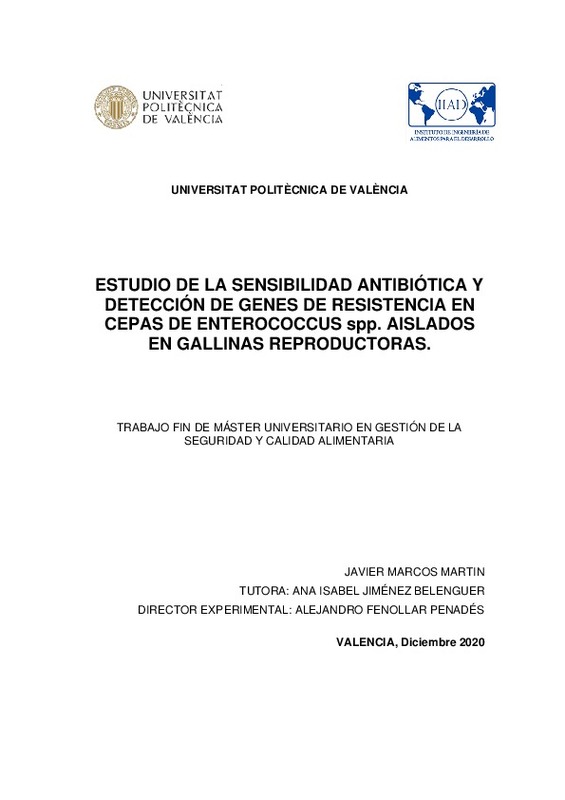|
[ES] El incremento de bacterias resistentes y multirresistentes a los antibióticos es un problema actual de salud pública. Los animales destinados al consumo humano suponen un importante reservorio de cepas resistentes ...[+]
[ES] El incremento de bacterias resistentes y multirresistentes a los antibióticos es un problema actual de salud pública. Los animales destinados al consumo humano suponen un importante reservorio de cepas resistentes capaces de transmitir genes de resistencia a bacterias potencialmente patógenas. Debido a la importancia del sector avícola en nuestro país, se ha realizado un estudio a partir de cepas de Enterococcus spp. aisladas de gallinas reproductoras de diferentes edades con el fin de conocer la prevalencia de las resistencias a antibióticos de interés clínico.
Se realizó una identificación de especies de Enterococcus spp. en gallinas, con el objetivo de ver el tipo de cepas que predominan en estos animales. Obteniendo un 79,6% E. faecium y un 20,4% de la especie E.faecalis. Posteriormente se estudió la tasa de resistencia a varios antibióticos de uso clínico. Con un resultado del 88,4% de cepas con al menos una resistencia a un antibiótico y un 13,7% de cepas resistentes a más de un antibiótico. La mayoría de las resistencias se observaron en Tetraciclinas (88%) y en Eritromicina (36%). El estudio de los perfiles de genes de resistencia emrA y emrB en aquellas cepas con resistencia a Eritromicina y Dalfopristina/Quinupristina mostró que la presencia de estos genes fue de un 83% en muestras con resistencia a Eritromicina y un 88% en muestras resistentes a Dalfopristina/Quinupristina.
Con los resultados obtenidos en este trabajo se establece una elevada presencia de los géneros E. faecalis y E. faecium en la microbiota intestinal de las aves. También se ha visto un elevado número de resistencias a antibióticos que en la actualidad tienen uso clínico. Se ha establecido una posible relación entre los genes emrA y emrB a la resistencia de Eritromicina y Dalfopristina/Quinupristina.
[-]
[EN] The growth of antibiotic resistant and multiresistant bacteria is a current public health problem. Animals destined for human consumption represent an important reservoir of resistant strains capable of transmitting ...[+]
[EN] The growth of antibiotic resistant and multiresistant bacteria is a current public health problem. Animals destined for human consumption represent an important reservoir of resistant strains capable of transmitting resistance genes to potentially pathogenic bacteria. Due to the importance of the poultry sector, a study has been carried out using strains of Enterococcus spp. isolated from breeding hens of different ages in order to determine the prevalence of antibiotic resistance of clinical interest.
It was done a species identification in Enterococcus spp. in broilers. In order to see the type of strains that predominate in these animals. Obtaining 79,6% E. faecium and 20,4% E. faecalis. Subsequently, the resistance rate to various antibiotics clinical use was studied. With a result of 88,4% of strains with at least one resistance to one antibiotic and 13,7% of strains resistant to more than one antibiotic. Most of the resistances were observed in Tetracyclines (88%) and in Erythromycin (36%). The study of the profiles of resistance genes emrA and emrB in those strains with resistance to Erythromycin and Dalfopristin/Quinupristin showed that the presence of these genes was 83% in samples with resistance to Erythromycin and 88% in samples resistant to Dalfopristin/Quinupristin.
With the results obtained in this work, a high presence of the genera E. faecalis and E. faecium is established in the intestinal microbiota of broilers. Has also been seen a high number of resistances to antibiotics that are currently in clinical use. A possible relationship between the emrA and emrB genes to Erythromycin and Dalfopristin/Quinupristin resistance has been established.
[-]
|







